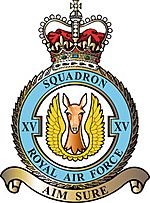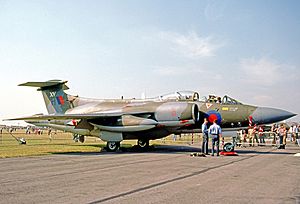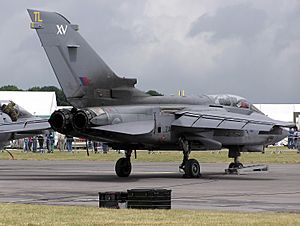No. 15 Squadron RAF facts for kids
Quick facts for kids No. XV Squadron RAF |
|
|---|---|

Squadron badge
|
|
| Active | 1 March 1915 – 1 April 1918 (RFC) 1 April 1918 – 31 December 1919 (RAF) 24 March 1924 – 15 April 1957 1 September 1958 – 31 October 1964 1 October 1970 – 1 July 1983 1 September 1983 – 18 December 1991 1 April 1992 – 31 March 2017 |
| Country | |
| Branch | |
| Type | Flying squadron |
| Motto(s) | Aim Sure |
| Battle honours |
|
| Disbanded | 31 March 2017 |
| Insignia | |
| Squadron badge heraldry | A hind's head affrontee erased at the neck between wings elevated and conjoined in base. The badge was a modification of the hart emblem used previously, changed to highlight the fact that the Hawker Hind was in service with the squadron when the badge was authorised. Approved by King Edward VIII in May 1936. |
| Squadron codes | EF (Nov 1938 – Sep 1939) LS (Sep 1939 – Apr 1951) DJ (1943) EA–EZ (Sep 1983 – Dec 1991) D (Tornados) TA–TZ (Apr 1992 – 2006) |
No. XV Squadron was a famous squadron of the Royal Air Force (RAF). It was known for flying many different types of aircraft over its long history. Most recently, it used the Tornado GR4 jet from RAF Lossiemouth.
The squadron was also an important training unit. It taught new pilots and Weapon Systems Officers (WSOs) how to fly the Tornado GR4. They learned how to use the aircraft and its weapons effectively. The squadron was officially closed on March 31, 2017.
Contents
A Brief History of No. XV Squadron
World War I: Early Days and Reconnaissance
No. 15 Squadron first started on March 1, 1915, at Farnborough Airfield. It began as a training group for the Royal Flying Corps, which was the air force before the RAF. They mostly flew Royal Aircraft Factory B.E.2 planes, which were used for scouting and observation.
In December 1915, the squadron moved to France. Their job was to fly over enemy lines and gather information for the army. During the Battle of the Somme in 1916, they faced many dangers. They lost many planes and pilots due to attacks from the ground and German fighter planes.
In 1917, they helped during the Arras offensive. They later got new planes called Royal Aircraft Factory R.E.8s, which pilots nicknamed "Harry Tate." These planes stayed with the squadron until the end of World War I. For the big tank attack at the Battle of Cambrai in late 1917, the squadron had a special job. They had to check that troops and equipment were well hidden before the attack.
The squadron returned to the United Kingdom in February 1919 and was officially closed down in December of that year.
Between the World Wars (1919–1939)
The squadron was restarted on March 20, 1924. For a while, it helped test new bomber aircraft. In 1934, it reformed as a light bomber squadron at RAF Abingdon, flying Hawker Hart planes. The squadron's leader, Squadron Leader T W Elmhirst, started the tradition of writing the squadron number using Roman numerals, like "XV."
They later flew Hawker Hind planes and then Fairey Battle planes in 1938.
World War II: Bombing Missions
When World War II began in September 1939, No. 15 Squadron flew to France with their Fairey Battle bombers. After returning to the UK, they changed planes several times. They flew Bristol Blenheims, then Vickers Wellingtons. Later, they became one of the first squadrons to use the large Short Stirling bomber.
A famous Stirling bomber was named MacRobert's Reply. It was donated by Lady MacRobert in memory of her three sons who died serving in the RAF.
In 1943, the squadron switched to Avro Lancaster bombers and was based at RAF Mildenhall. Towards the end of the war, in 1945, they helped with "Operation Mana." This involved dropping food to Dutch civilians who were suffering. They also flew missions to bring back Allied prisoners of war.
The Cold War Era
After World War II, in 1947, the squadron replaced their Lancasters with Avro Lincolns. In 1951, they took on a new role: nuclear strike. For this, they used Boeing Washington planes.
In 1953, No. XV Squadron started flying the English Electric Canberra B.2 bomber. They used the Canberra in combat during the Suez Crisis in 1956. They dropped more bombs than any other squadron during that short conflict. The squadron was then closed down on April 15, 1957.
It reformed again on September 1, 1958, becoming the second squadron to fly the Handley Page Victor bomber. In 1962, they were ready for action during the Cuban Missile Crisis. In 1963, they went to Singapore to show strength during the Indonesia-Malaysia Confrontation. After this, they were disbanded again in October 1964.
Nuclear Missions and the Tornado Era

In 1970, the squadron reformed once more, flying the Blackburn Buccaneer S.2B. They moved to RAF Laarbruch in Germany. Their job was to support the army in Europe, first with regular weapons, and later with tactical nuclear bombs if needed.
In 1983, the squadron changed their Buccaneers for Tornado GR.1 jets. This made them the first Tornado unit in Germany. They continued their role of delivering nuclear weapons until 1991, when the squadron was disbanded again.
Desert Storm and Beyond
During the build-up to Operation Desert Storm in 1991, the squadron was sent to Bahrain. Their mission was to destroy Iraqi air force bases by bombing their runways. On one mission, two of their crew members, John Peters and John Nichol, were shot down and became prisoners of war. Squadron Leader Pablo Mason led many bombing missions during the conflict.
In 1992, No. 45 (Reserve) Squadron, which trained Tornado pilots, changed its name to No. 15 (Reserve) Squadron. They continued to train pilots and teach them how to use the Tornado's weapons. They moved to RAF Lossiemouth in 1994.
The squadron officially closed down on March 31, 2017. This was in preparation for the Tornado GR4 jets being retired from service in 2019. The aircraft and crews from No. 15 Squadron joined other front-line squadrons at RAF Marham.
Aircraft Flown by No. XV Squadron
No. 15 Squadron flew many different types of aircraft throughout its history. Here is a list of some of them:
- Royal Aircraft Factory B.E.2c (1915–1917)
- Bristol Scout (1916)
- Royal Aircraft Factory B.E.2d/e (1916–1917)
- Royal Aircraft Factory R.E.8 (1917–1919)
- Airco DH.9A (1924–1926)
- Hawker Horsley (1926–1934)
- Various types for testing (1924–1934)
- Hawker Hart (1934–1936)
- Hawker Hind (1936–1938)
- Fairey Battle (June 1938 – December 1939)
- Bristol Blenheim Mk IV (December 1939 – November 1940)
- Vickers Wellington Mk IC (November 1940 – May 1941)
- Short Stirling Mk I/ Mk III (April 1941 – December 1943)
- Avro Lancaster B.I/B.I(Special)/B.III (December 1943 – 1947)
- Avro Lincoln (1947–1950)
- Boeing Washington B.1 (1951–1953)
- English Electric Canberra B.2 (1953–1957)
- Handley Page Victor B.1 (1958–1964)
- Blackburn Buccaneer S.2B (1970–1983)
- Panavia Tornado GR1 (1983–2002)
- Panavia Tornado GR4 (2001–2017)
See also
- List of Royal Air Force aircraft squadrons
- "Pablo" Mason – A Squadron Leader during the Gulf War
- Phil Lamason



